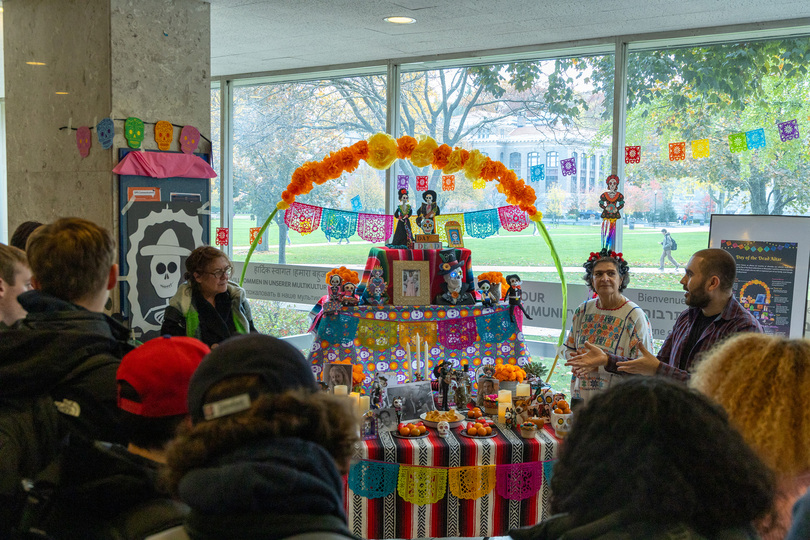Campus Día de Muertos celebration honors authentic, nostalgic tradition

An ofrenda is a traditional Mexican altar used in Día de Muertos celebrations. For the SU event in HBC on Wednesday, the main element was a large, colorful ofrenda in the corner of the room. Jack Henry | Staff Photographer
Get the latest Syracuse news delivered right to your inbox.
Subscribe to our newsletter here.
A traditional Mexican ofrenda with vivid Marigold flowers and colorful papeles picados, or punched papers, greeted people in the lobby of Huntington Beard Crouse Hall at this year’s Día de Muertos Celebration Event.
“The Día de Muertos is a manifestation of the cultural richness existing in our Spanish-speaking community,” said M. Emma Ticio Quesada, the associate chair of the College of Arts and Science’s Department of Languages, Literatures and Linguistics. “It shows a particular interpretation given in our cultures to the issue of how to deal with death as human beings and embodies the rich contributions in our history.”
Although the holiday originated in Mexico, Día de Muertos is now celebrated all over Latin America and the United States. Attendees at HBC Crouse said the sacred time of remembrance allows people of Latin descent to honor their loved ones while celebrating the lives of those around them.
The celebration helps share “what it means to be Mexican,” said Jose A. Romero-Reyna, a graduate student in the College of Arts and Sciences. He said it’s good to have the space in the university to share his Mexican culture with others, regardless of their own cultural background.
“I believe that in this celebration, we share what it means to be Mexican, and that’s why I connect so deeply with this tradition,” Romero-Reyna said. “It’s because I have Mexican culture, and I have loved ones I want to remember and welcome on the Día de Muertos.”
Traditionally, those celebrating the holiday create ofrendas, or altars, that represent the lives of family, friends and pets who have passed away. The altar then serves as a gate to welcome their loved ones back into the land of the living. Ofrendas are filled with photos of loved ones and other personal items.

Along with the altar, visitors could participate in several art activities. One of these was a table with skulls that visitors could color and personalize.
Jack Henry | Staff Photographer
Other elements of the ofrenda include fluorescent orange and yellow Marigold flowers used to attract spirits into the mortal world, adorned calaveras (skulls), candles to guide the spirits of passed loved ones, salt to symbolize the earth and pan de muerto, a sweet Spanish bread.
At the event, Spanish professors and students came together to contribute to the community altar, bringing photos of passed loved ones and personal items that are representative of their respective cultures.
Ticio Quesada said that as SU’s ofrenda has grown by the year, people within the Spanish language program bring something new each time. This year, the event offered two art stations, one where attendees could design calaveras and another where they could create their own papeles picados.
Attendees compared the display of remembrance to their own family’s way of celebrating their deceased loved ones. Elizabeth Juaréz-Cummings, an associate professor of Spanish, said she misses Mexico around the holiday.
“During late October and early November the air is filled with the smell of incense, cempasuchil flowers (marigolds), cinnamon, orange, and many other characteristic aromas that are reminiscent of this celebration,” Juaréz-Cummings said. “The city centers also (are decorated) with flowers and decorations from typical calaveras, candles and more.”
At SU, the celebration has been running for over a decade. Although celebrations may differ from family to family, attendees said they all serve as a symbol of commemoration of a life well lived.
“The Día de Muertos is a celebration of life. We may feel sad about our family members not being with us anymore, but we celebrate their life, we share their accomplishments and all the happiness they brought to us when they were with us,” Ticio Quesada said.





